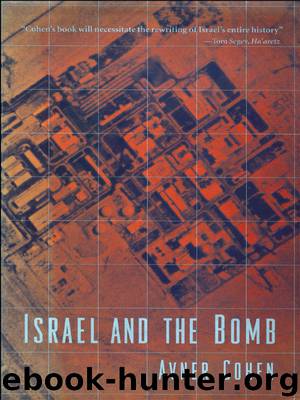Israel and the Bomb by Cohen Avner;

Author:Cohen, Avner;
Language: eng
Format: epub
Tags: HIS019000, History/Middle East/Israel, POL011000, History/Middle East/Israel
Publisher: Columbia University Press
Published: 1998-10-15T04:00:00+00:00
On November 2, 1966, a test with a special significance was conducted. It meant an end of an era of development, and a step that brought one of our primary weapons-systems to its final phases of development and production in RAFAEL. The test was completely successful, for we received an unequivocal experimental proof of the adequacy of the system that was developed at RAFAEL. We have waited for that result for many years.41
According to this interpretation, the test to which Mardor referred as something for which he had been waiting “for many years,” was a test of those aspects of the nuclear device that were under the responsibility of RAFAEL (perhaps a test of an entire implosion device, or a zero or near-zero yield test).42 Regardless of what was actually tested, weeks later the CIA disseminated new intelligence reports suggesting that Israel continued to produce bomb components, and that “assembly of a nuclear weapon could be completed in 6–8 weeks.”43 The American reports highlight Mardor’s struggle to maintain the integrity of RAFAEL, especially the integrity of the almost-completed “leading project.” By late 1966 Israel had completed the development and testing of all the components of its first nuclear device. This is not, however, equal to possessing a complete nuclear weapon, which needs to be tested in order to be of operational value.
Another element in a nuclear weapons system is the warhead’s delivery means—a plane or a surface-to-surface missile. According to French sources, in April 1963 the Israeli Ministry of Defense signed a contract for ballistic missiles with the French manufacturer Marcel Dassault. The contract was for the development of a two-stage, solid propellant ballistic missile capable of carrying a 750-kg warhead. The missile project, known as MD-620, or Jericho, conducted its fire testing in 1965. The first two-stage launch, on 23 December 1965, failed, but the second one, in March 1966, succeeded.44 In early 1966 the New York Times reported that Israel had purchased the first installment of thirty such missiles from France, and that they were under development.45 By the time Israel had completed the design work for its first nuclear device, it was still lacking a dedicated delivery system.
By 1966 Israel had thus obtained, or was about to obtain, the three components that constitute a nuclear weapons capability: fissile material production capacity, design knowledge, and access to delivery means. This was as significant as the political developments. In October 1963 Eshkol’s inner circle included Peres, Dayan, Meir, Eban, and Chief of Staff Zur. In 1966 Eshkol’s inner circle had drastically changed, counting Eban, Galili, Allon, Dinstein, and Chief of Staff Rabin as members. These two groups had different ideologies and worldviews. The new members of Eshkol’s close circle of advisers supported a strong conventional IDF and were interested in promoting a U.S.-Israeli security dialogue.
There was also a change in the security relations between the United States and Israel: American military supplies became available to Israel for the first time. Ben Gurion had hoped for this for years, but it was under Eshkol that the United States began to supply Israel with tanks and planes.
Download
This site does not store any files on its server. We only index and link to content provided by other sites. Please contact the content providers to delete copyright contents if any and email us, we'll remove relevant links or contents immediately.
| Africa | Americas |
| Arctic & Antarctica | Asia |
| Australia & Oceania | Europe |
| Middle East | Russia |
| United States | World |
| Ancient Civilizations | Military |
| Historical Study & Educational Resources |
Empire of the Sikhs by Patwant Singh(22765)
The Wind in My Hair by Masih Alinejad(4841)
The Templars by Dan Jones(4557)
Rise and Kill First by Ronen Bergman(4545)
The Rape of Nanking by Iris Chang(4022)
12 Strong by Doug Stanton(3419)
Blood and Sand by Alex Von Tunzelmann(3055)
The History of Jihad: From Muhammad to ISIS by Spencer Robert(2504)
Babylon's Ark by Lawrence Anthony(2430)
The Turkish Psychedelic Explosion by Daniel Spicer(2245)
No Room for Small Dreams by Shimon Peres(2235)
Gideon's Spies: The Secret History of the Mossad by Gordon Thomas(2234)
Inside the Middle East by Avi Melamed(2230)
Arabs by Eugene Rogan(2193)
The First Muslim The Story of Muhammad by Lesley Hazleton(2154)
Bus on Jaffa Road by Mike Kelly(2035)
Come, Tell Me How You Live by Mallowan Agatha Christie(2025)
Kabul 1841-42: Battle Story by Edmund Yorke(1921)
1453 by Roger Crowley(1880)
